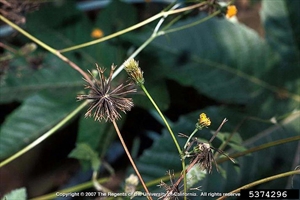- Widespread. Asia, Africa, North, South and Central America, Caribbean, Europe, Oceania. In most Pacific islands.
- Annual weed of crops, plantations, forests, pastures, waterways, gardens, parks, roadsides, waste lands, coastal and other disturbed sites. Produces large amounts viable, long-lasting, easily-dispersed seed, grows in range of habitats, developing dense populations, out-competing crop plants and native species. Alternative host for viruses (Tomato spotted wilt virus), nematodes (Meloidogyne, Rotylenchus and leaf miners (Liriomyza).
- Slender, erect, branching, up to 90 cm tall. Stems, square, hairless, green to purple. Leaves, opposite along stems, toothed margins, single at base, compound above (three leaflets). Flowerheads in clusters at end of branches, 7-8 mm across, yellow flowers in centre. Some with surrounding white petals-like structures. Fruits black, flattened with hooked bristles. Strong tap root.
- Spread: seed; clothing; water; contaminant of rice seed; vehicles.
- Biosecurity: high risk of introduction; contaminant of seed, clothing. One of the worst weeds in New Caledonia and Guam. On Global Invasive Species Database of alien invasive species (IUCN, 2020).
- Biocontrol: little known.
- Cultural control: hand weed, hoe or cultivate mechanically between rows; shade by intercropping; vehicle hygiene.
- Chemical control: in Australia: diuron; glyphosate (and Fiji); bentazone; metribuzin; 2,4-D; glufosinate-ammonium; pendimethalin; dicamba; fluroxypyr.







